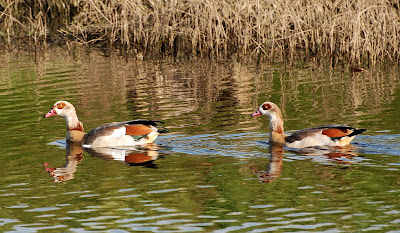This RSPB Media Release might be of interest to readers...
Bustards on Tour
Great
bustards released as part of an ambitious project that is bringing the birds
back to the UK are causing a stir by conducting their own tours of southern
England.
Brought
from Saratov in Russia, this year’s great bustards were released in September,
and there are currently 17 in the wild.
Andrew
Taylor, Great Bustard LIFE Project Adviser for RSPB said; “This year’s released
birds have been out for eight weeks now, and most are starting to roam more
widely around their original release sites.
“Some
however have been rather more adventurous than others! Black Six, named after
the numbered black wing tag she carries, was last seen by project staff on the
day of her release. She spent a couple of weeks on a neighbouring farm, but then
went off the radar.
“On dawn of
5th November, a great bustard was seen flying south from Portland Bill in
Dorset, and then the following lunchtime we received a report of Black Six in a
field at South Huish, near Kingsbridge in Devon. She flew north an hour
later.
This week
[21 November 2011] we received a report of another bustard, this time without
wingtags, but with a radio transmitter, on land owned by The National Trust near
Langton Matravers in south Purbeck. They certainly are getting
around”
Conservationists are looking forward to seeing where the bustards
will fly to next, but are appealing to the public for
help.
Trace
Williams Great Bustard LIFE Manager for RSPB said: “Of the 17 birds in the wild
we are able to track nine directly as they have radio and satellite
transmitters. The remaining birds however have no transmitters so we need people
who see them, and notice the very visible numbered wing tags, to let us know by
calling 01980 671466.”
The great
bustard is a globally threatened species that is listed on Annex I of the EC
Birds Directive. As a species of concern in Europe, the re- introduction of the
birds to the UK is generously supported by the EU LIFE fund and co-ordinated by
a partnership of The Great Bustard Group, Natural England, University of Bath
and the RSPB.
It was
formerly widely distributed across large parts of lowland Europe, but started to
decline in the 18th century and is now absent from much of its original range.
It became extinct from the UK in 1832, and from numerous other European nations
over the rest of the 19th and the 20th centuries. It is responding well to
conservation and many populations are now increasing.
Visitors
are welcome to the great bustard release site to learn about the project and see
the spectacular scenery and wildlife of Salisbury Plain. To book a visit phone
07817 971327 or email visit@greatbustard.org



















